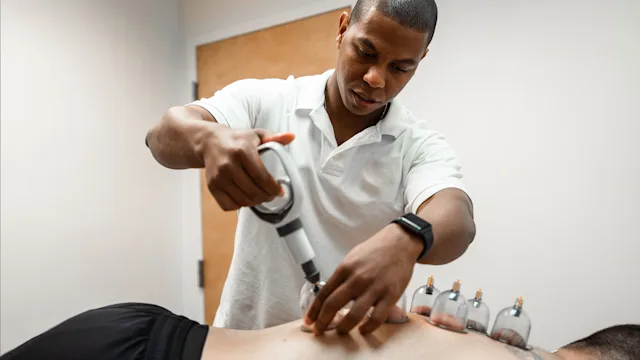Key takeaways:
Acupuncture is a form of treatment for many types of medical problems. It is rooted in traditional Chinese medicine.
Acupuncture works by stimulating specific points on the body that are believed to restore balance to the flow of energy. This energy, known as “qi,” is thought to affect someone’s health.
Acupuncture is most commonly used to treat pain and is generally safe for most people.
The idea behind acupuncture is that health is related to “qi,” which means “vital energy.” Any disruption in the flow of qi — whether it gets lower or higher — can cause illness. The goal of acupuncture is to treat illness by restoring balance to the flow of qi through specific channels in the body, known as meridians.
Many people — about 1.5% of adults in the U.S. — have used acupuncture at some point in their lives. Acupuncture is generally safe and can be a useful additional treatment option for some people. Read on to learn about what acupuncture is, how it works, and if it may be right for you.
What is acupuncture?
Acupuncture means “needle penetration.” According to the theory behind acupuncture, your body has more than 2,000 points, called “acupoints,” connected by pathways, or meridians. People believe that the flow of qi through these various pathways affects your health.
Search and compare options
With acupuncture, needles are applied to these points. This is thought to improve the flow of qi and restore health and wellness.
In some cases, the following can be used instead of needles:
Pressure
Heat
Electrical energy
Laser
Ultrasound
Does acupuncture work?
Some studies show that acupuncture can help treat chronic pain. Other studies suggest that there may be a placebo effect. Studies on placebo effects often compare acupuncture with "sham acupuncture." This is a procedure where an acupuncturist inserts needles into the body but not at actual acupoints. The purpose of this is to see if simply inserting needles has the same beneficial effect as real acupuncture.
One study compared acupuncture with a placebo and reviewed many acupuncture and sham acupuncture trials. It found that there was not much difference in chronic pain improvement between people who had actual acupuncture and those who just thought they did. Acupuncture and sham acupuncture seemed to relieve pain similarly. But both relieved pain more than medications alone. This may mean that, for some people, just the experience of having acupuncture can help treat pain, even if the procedure itself does not.
How does acupuncture work?
Acupuncture involves inserting very thin solid steel needles into the skin at various points on the body. A professional acupuncturist performs the procedure. Typically, they place 3 to 15 needles per session, and a session usually lasts about 20 minutes. Sometimes, they apply heat or small amounts of electricity to the needles during the treatment session.
Read more like this
Explore these related articles, suggested for readers like you.
Experts don't know exactly what happens in the body during acupuncture. Some researchers think that the procedure may cause hormone changes or stimulate the immune or nervous system. In some studies, magnetic resonance imaging has shown that acupuncture may affect the central nervous system.
Does acupuncture hurt?
Different people may experience acupuncture differently. Most people experience little to no pain. Some people report feeling pressure or a slight ache at the needle insertion point. Others say that they feel relaxed or energized. Sometimes, people feel a numbness or tingling at and around the needle insertion point. Many acupuncturists think this means that the needle is in the right spot and treatment is working.
If you do not feel any numbness, tingling, pain, or discomfort, the needle might not be in the right spot. In that case, the acupuncturist might need to change the position of the needle.
What are the benefits of acupuncture?
Acupuncture may help treat various medical problems. Some common conditions that may benefit from acupuncture include:
Nausea and vomiting
Dental pain
Asthma
Muscle pain
Tennis elbow
Depression
Chronic pain is the most common reason that people use acupuncture.
Acupuncture side effects: Is acupuncture safe?
Acupuncture is generally safe for most people. You may experience side effects –– like bleeding or bruising –– at the needle insertion site. But these are usually mild and get better on their own. You may also experience other side effects, such as:
Lightheadedness
Dizziness
Fainting
Vomiting
Low blood pressure
More serious — but rare — issues can happen, including:
Nerve or organ injury from needle penetration
Infection from contaminated needles
Needle breakage requiring surgical removal
These issues are very rare, especially among experienced acupuncturists. And the risks of acupuncture, especially serious ones, have declined over the past 20 to 30 years.
Is acupuncture safe if you’re pregnant or have a medical condition?
You may wonder if acupuncture is safe for pregnant people or people with certain medical conditions, such as those that can make you bleed more easily. Acupuncture can be safe even during pregnancy or if you are taking blood-thinning medications.
Medical conditions that may make acupuncture more risky include having an implanted defibrillator or a history of psychosis. If you have a defibrillator, you should avoid electro-magnetic stimulation. It may cause the defibrillator to shock inappropriately. Otherwise, you can receive acupuncture safely.
If you have a history of delusions or psychosis, it is best to avoid acupuncture. The procedure may trigger an episode and raise your risks of a serious complication. Acupuncturists also do not recommend acupuncture if you have an infection.
How to know if acupuncture is right for you
If you are considering acupuncture, first talk with your healthcare provider. The American Academy of Medical Acupuncture recommends that you already have an established diagnosis and then ask your healthcare provider about whether or not acupuncture may help treat your symptoms.
Because acupuncture is generally safe for most people, there may be no harm in adding it to your existing medical treatments. But having a diagnosis may help guide your acupuncture treatment so that you get the most benefit out of it.
Once you have a diagnosis and the go-ahead from your healthcare provider, find a licensed acupuncturist. Your healthcare provider may be able to give you a referral. If not, you can visit the American Academy of Medical Acupuncture website.
Also, remember to consider cost and insurance coverage. Some insurance plans may cover acupuncture, but not all do.
The bottom line
Acupuncture can be a helpful additional treatment for pain or other medical problems. Acupuncture is generally safe and comfortable for most people. While acupuncture does have some risks, serious risks are few and very rare. It is important to talk to your healthcare provider about acupuncture before trying it.

Why trust our experts?



References
American Academy of Medical Acupuncture. (n.d.). Doctor, what’s this acupuncture all about?
American Academy of Medical Acupuncture. (n.d.). Frequently asked questions.
Ernst, E. (2010). Acupuncture – a treatment to die for? Journal of the Royal Society of Medicine.
Johns Hopkins Medicine. (n.d.). Acupuncture.
Lao, L. et. al. (2003). Is acupuncture safe? A systematic review of case reports. Alternative Therapies in Health and Medicine.
Linde, K., et al. (2016). Acupuncture for the prevention of tension-type headache. The Cochrane Database of Systematic Reviews.
Longhurst, J. C. (2010). Defining meridians: A modern basis of understanding. Journal of Acupuncture and Meridian Studies.
Madsen, M. V., et. al. (2009). Acupuncture treatment for pain: Systematic review of randomised clinical trials with acupuncture, placebo acupuncture, and no acupuncture groups. British Medical Journal.
Snyder, D. D. (2019). Acupuncture gone awry: A case report of a patient who required surgical removal of two single-use filament needles following acupuncture treatment. Journal of Manual and Manipulative Therapy.
Van Hal, M. et. al. (2023). Acupuncture. StatPearls.
Vickers, A. J., et. al. (2017). Acupuncture for chronic pain: Update of an individual patient data meta-analysis. The Journal of Pain.















